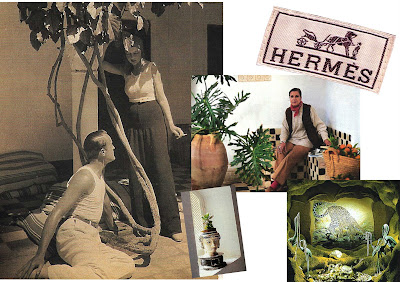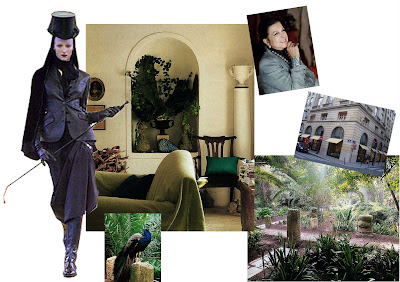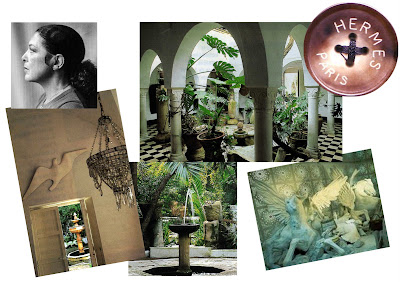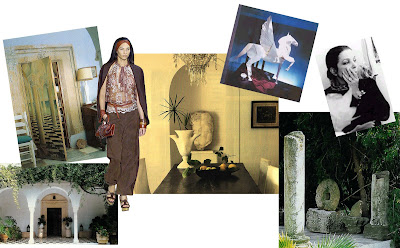For generations of Parisians’, and those who regularly make the trip to Paris, will tell you that Hermès’ store windows are meant to make you dream. That is why crowds jostle for position to catch a glimpse of the fantastic scenarios crafted out of silk, coral and leather that are a voyage into the imagination of their creator, Leila Menchari. Her poetic displays have included a huge origami hoarse that looked as if it had been created from one of Hermès famous silk scarves, gazelles grazing amongst stacks of fine china piled high with colorful macaroons and Tuareg jewelry laid out on petrified wood that recalled the African Sahara.
 Clockwise: A picture of Jean and Violet Henson taken in the 1930’s under the portico of their house in Hammamet; Leila Menchari seated between an earthen jar once used for transporting olive oil and a basket of tangerines from her garden; A window display at Hermès concocted by Menchari for the Year of Africa; Resting by a moucharabieh-clad window in the house is an antique porcelain head from the town of Grottaglie in Italy.
Clockwise: A picture of Jean and Violet Henson taken in the 1930’s under the portico of their house in Hammamet; Leila Menchari seated between an earthen jar once used for transporting olive oil and a basket of tangerines from her garden; A window display at Hermès concocted by Menchari for the Year of Africa; Resting by a moucharabieh-clad window in the house is an antique porcelain head from the town of Grottaglie in Italy.Seated behind a large desk in her atelier, Leila Menchari resembles a cross between Nancy Cunard and Coco Chanel, exuding an effortless chic with her piles of bangles and carefully sculpted hair. The space is filled with the exotic ingredients she uses to tell her stories; baskets of antique ribbons, mounds of costly fabrics, and even a number of densely embroidered saddles crafted from crocodile, ostrich skin and lace. Arranged along a shelf, directly behind her desk, is a collection of one of a kind Birkin bags destined for her own private museum. Hermès has given her carte blanche to create different variations of the famous bag for her window displays and no material seems to be off limits. Some are made out of candy wrappers, fur, straw and even feathers. While other examples were conceived from outrageously colored silk scarves, plastic and glass. These bags were never intended for sale and are not even accessible to the public. On very rare occasions a member or close friend of the Hermès family is granted the right to have one, but even then Menchari is reluctant to part with it.
Since 1977 she has been responsible for concocting the most alluring window displays for the Maison Hermès store in Paris, as well as designing some of its most iconic scarves. She understood early on that the shop window was more than just a platform for showcasing the latest bag or belt. In the right hands it could embody the luxurious world a brand wishes to represent, and Menchari’s in particular are a feast for the eyes, raising the window display to an art form.
Born into a family of wealthy landowners by the sea near Hammamet in Tunisia, her curiosity for nature and the exotic were nurtured at an early age. As a child she had begun to cultivate a taste for beautiful things and materials which would one day lead her to the doorstep of some of the most august Parisian fashion houses. In October 2006 she received the Golden Dido award, the highest distinction awarded to a woman in Tunisia, for her contribution to Tunisia 's cultural influence in the world. In May 1995, she became a "Chevalier de l'ordre du mérite" of France , and in 1998 Tunisia 's President decorated her with the "Commandeur de l'ordre de la Republique Tunisienne ."
Despite such recognition from her homeland, Menchari doesn’t define herself as a Tunisian, but rather a citizen of the world. This is in part due to the multicultural upbringing she had as a child in Tunisia. In fact her life is peppered with a cast of extraordinary characters who instilled in her a sense of wanderlust and fed her creatively.
As fate would have it, Leila’s journey began when she was eight years old. Her mother had sent her on an errand to deliver a message to the neighbors, "My mother will not be coming to play cards this afternoon." Unfortunately for her mother, she got the wrong house, but fortunately for Leila her destiny came in the form of Jean and Violet Henson, a bohemian Anglo-American couple of aristocratic bearing, who had settled in this ancient Roman colony on the shores of Tunisia.
By the time they had reached Hammamet in 1925, this tall and striking pair had lived a life of adventure full of travel and art. In Paris Jean, a native of Louisiana, immersed himself in the heady world of the Dadists, posing for Man Ray and befriending Cocteau, Berard and Serge Lifar. While Violet chose to break away from a cosseted English upbringing by traveling the world from Athens to Cairo. It was that independent and slightly rebellious spirit that lead them to Tunisia, an exotic place, considered off the beaten track by many in their circle.
 Clockwise: Leila Menchari and her signature bangles; The Hermès store on Paris’ Faubourg Saint-Honore; A view of the lush gardens at Hammamet; A niche in the living room holds a vase once owned by the Medicis, a pair of oversized goblets by Bernard Palissy, and large murcury dipped pendants in the shape of grapes, acquired on a trip to Rajasthan; A peacock in the garden; A look from Jean Paul Gaultier’s first collection for Hermès, Fall 2004.
Clockwise: Leila Menchari and her signature bangles; The Hermès store on Paris’ Faubourg Saint-Honore; A view of the lush gardens at Hammamet; A niche in the living room holds a vase once owned by the Medicis, a pair of oversized goblets by Bernard Palissy, and large murcury dipped pendants in the shape of grapes, acquired on a trip to Rajasthan; A peacock in the garden; A look from Jean Paul Gaultier’s first collection for Hermès, Fall 2004.Together they built their dream home, a low white washed house of colonnaded courtyards and spacious rooms, surrounding it by a series of gardens that would prove to be their most lasting legacy. They filled it with fountains and rare species of plants shipped from half way around the world, as well as quiet a few specimens from down the road. Scattered throughout the lush foliage were ancient roman columns and pediments, part of Jean and Violet’s extensive collection of antiquities from Carthage and other archeological sites.
They also filled their home with eclectic treasures culled from their travels and the friends they made along the way. In their double height living room, heirloom furnishings were paired with lamps by Giacometti, photographs by Horst and their extensive collection of books. While drawings by Christian Berard and other notable artists hung along the hallway’s pale lilac walls.
It was in this magical atmosphere that Jean and Violet welcomed a steady stream of friends, artists and writers. Entertaining them on their cushion strewn terrace, in their legendary garden, and on the beach a few steps away.
Little did Leila know from that initial meeting that she would eventually become the Hanson’s spiritual daughter. She was fascinated by them, absorbing all their otherness, while they intern exposed her to a world of art and color. As the years went by they also encouraged her to pursue her dreams of studying art; a wish that would defy the social conventions of her culture at a time when woman were expected to marry young.
Menchari was also encouraged by her family, who were very progressive. In fact Menchari came from a long line of headstrong woman. Her grandmother was one of the first Tunisian women to remove the veil in public, and began lecturing and educating Tunisian women about their rights.
 Clockwise: The rooms in Menchari’s house overlook a colonnaded courtyard with a fountain surrounded by exotic plants; A window display inspired by Pegasus for the Maison Hermès; one of several gurgling fountains found throughout the garden; The Dove by Diego Giacometti above the entrance, became a symbol of the Henson’s house in Hammamet; A portrait of Leila Menchari in the 1970’s by Edouard Boubat.
Clockwise: The rooms in Menchari’s house overlook a colonnaded courtyard with a fountain surrounded by exotic plants; A window display inspired by Pegasus for the Maison Hermès; one of several gurgling fountains found throughout the garden; The Dove by Diego Giacometti above the entrance, became a symbol of the Henson’s house in Hammamet; A portrait of Leila Menchari in the 1970’s by Edouard Boubat.After graduating from the Ecole des Beaux-Arts de Tunis, she moved to Paris to pursue her studies in painting at the l’école Nationale Supérieure des Beaux-Arts. It was there that she met fellow Tunisian Azzedine Alaia, who introduced her to the world of fashion. Through him she met the couturier Guy Laroche, who hired her as an in house model after her graduation from l’école Nationale. Soon after she befriended Annie Beaumel at Hermès, becoming her assistant and head illustrator at the fashion house. That was, until 1977 when she was appointed as head stylist at the prestigious Maison by non-other than Jean Louis Dumas Hermès, the president of Hermès.
Although she travels around the world regularly to source out new artisans and feed her inspirations, her attachment to Tunisia has also fed her professional career. This can be seen in her choice of materials to illuminate her window displays, such as incense, leather, gold and silks. In addition to the sumptuous window displays she puts together for Hermès, she has published two books, one on her work (an out of print tome that has become a collectors item) and the other on the gardens of Hammamet. She also recently designed the interiors for the Port Palace Hotel in Monte Carlo. It’s sleek and modern decor have made it a rarity amongst the gilt laden stuffiness of the Principality’s other luxury hotels.But despite her career, her travels and the fascinating people she’s met along the way, Princess Grace of Monaco and General Charles De Gaule to name a few, Menchari considers her most important role to be that of the keeper to the Hanson’s legacy. After Violet’s death, Leila watched over Jean, who eventually bequeathed their villa to her. Today she is just as devoted to the villa and its gardens, which inspired the perfume she created for Hermès, "Jardin en Méditerranée". Every summer, when Hermès reluctantly spares her for a month, she returns to Hammamet to reconnect with her past and remember where her dreams first took root.
 Clockwise: Menchari frequently incorporates horses into her displays, a symbol of the House’s equestrian roots, such as this origami version; Menchari captured in the 80’s in a pensive moment; fragments of ancient columns and pediments line the gardens paths, a reminder that Tunisia was once a part of the Roman Empire; In the dinning room an alcove shelters a Roman torso not far from a painting by Bérard. On the table, bought in Spain, lies a vase by Diego Giacometti and carved African bowls. Menchari covered the dining room chairs in Hermès’ Chevrons fabric, while the crystal chandelier above had been installed by the Hensons; A look from Hermès’ Spring 2006 collection; The inner courtyard, through which one enters Menchari’s villa in Hammamet, is populated by a menagerie of exotic pheasants and peacocks; A trompe l’oeil door in Menchari’s villa hides the china cupboard.
Clockwise: Menchari frequently incorporates horses into her displays, a symbol of the House’s equestrian roots, such as this origami version; Menchari captured in the 80’s in a pensive moment; fragments of ancient columns and pediments line the gardens paths, a reminder that Tunisia was once a part of the Roman Empire; In the dinning room an alcove shelters a Roman torso not far from a painting by Bérard. On the table, bought in Spain, lies a vase by Diego Giacometti and carved African bowls. Menchari covered the dining room chairs in Hermès’ Chevrons fabric, while the crystal chandelier above had been installed by the Hensons; A look from Hermès’ Spring 2006 collection; The inner courtyard, through which one enters Menchari’s villa in Hammamet, is populated by a menagerie of exotic pheasants and peacocks; A trompe l’oeil door in Menchari’s villa hides the china cupboard.
© THE POLYGLOT (all rights reserved) CHICAGO-PARIS

7 comments:
I would like to contact you about your work, but I cannot find an email address.
Loved it! Very informative! So serene. Where did you get the pics of her home?
John,
You can email me at z.polyglot@gmail.com
fascinated by Leila,
i watch the amazing moovie from J Dayan... a marvelous world.
hope to show her , one day my paints about the black ladies...
Beautiful post. I just went to see an exhibition about Leila Menchari's work called Hermes and the Orient here in Paris. Definitely worth seeing if you happen to be in Paris
Leila Menchari is an absolutely amazing woman, extraordinarily talented and creative, and her devotion to the Jean Henson legacy is most inspiring. She has the sensitivity and heart to understand things at the deepest level, and she continues to accomplish the "impossible". Visiting the Henson house after many years, decades, invited by Leila Menchari, was a huge heart opening experience, reminding us again of how extraordinary Leila is and how she does follow her commitments and her heart! Thank you, Lili!!!!
Isabel and David Taylor
Leila Menchari is the most amazing, creative and talented woman imaginable! Knowing her has been a source of inspiration for decades.
The Henson legacy which she fulfills so perfectly, the way she maintains that amazing property, her own amazing life and her charm and beauty, all of what Leila is and represents is awesome!
Leila is more than a Magician: she is a creative Goddess!!!!!
We admire honor and respect her!
Isabel and David Taylor
Post a Comment